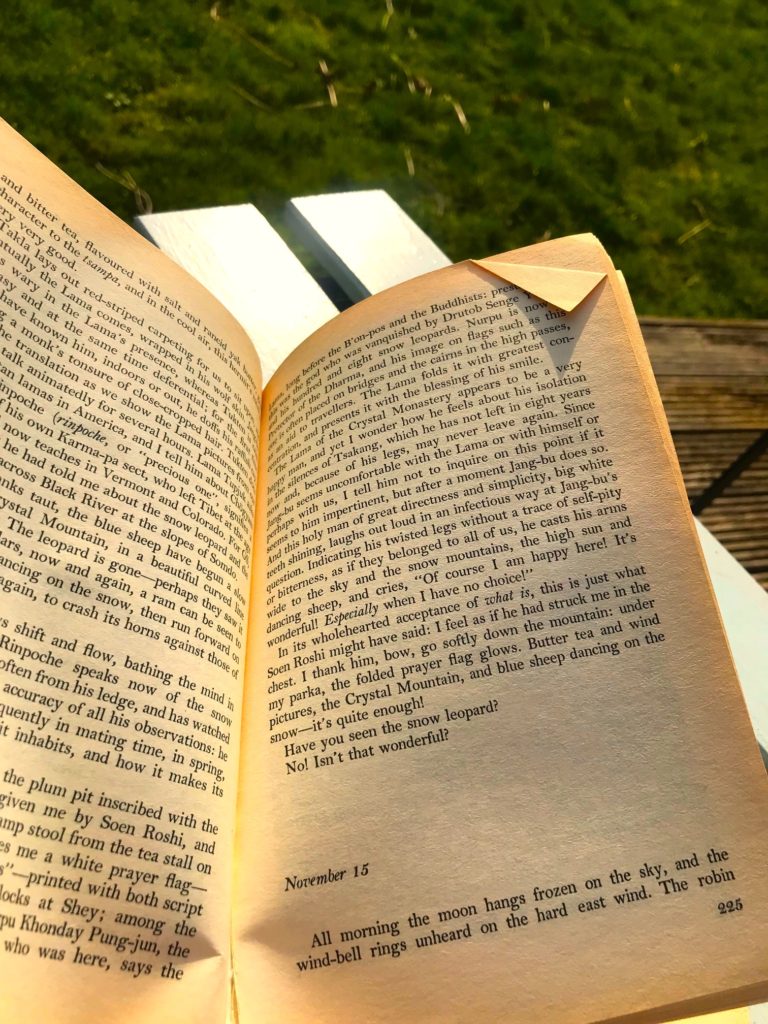
On the 28th September 1973 Peter Matthiessen set off with famed zoologist and friend George Schaller, headed deep into the Himalayan mountains. We can be sure of the date they left because Matthiessen’s award-winning travel memoir The Snow Leopard comes to us in diary form, with one entry for every day they trek to and from the Crystal Monastery, tucked away in the icy peaks of Nepal.
The linear format of his book and the outward journey it depicts juxtaposes with Matthiessen’s memories of his wife’s losing battle with cancer, alongside the inward spiritual journey that he is also taking as they forge further into the abyss.
Accompanied by Nepalese porters and guides – most of whom Matthiessen writes about with a generalised scorn that reads uncomfortably today – this expedition is made in the name of Western science, but its content is very much a study of Eastern philosophy. Zoologist George Schaller is seeking the rare Himalayan blue sheep, with the somewhat amusing aim of hoping to confirm once and for all whether it is, in fact, a sheep or, rather, a goat. (Spoiler: it’s not a sheep. And nor, as it goes, is it blue.)
It might appear that their trip is also about glimpsing the elusive snow leopard, given the book’s title. And for parts, it surely is. But slowly and beautifully Matthiessen withdraws from this urge for sensory discovery. And a meeting with a Buddhist Lama in the Crystal Monastery hidden within the mountains wipes this urge out, seemingly for good. Matthiessen tentatively asks the Lama how he feels about the fact that he may never again leave the “isolation in the silences of Tsakang”, given the old man’s failing legs. Matthiessen is amazed to find the Lama responds with laughter:
“Indicating his twisted legs without a trace of self-pity or bitterness, as if they belonged to all of us, he casts his arms wide to the sky and the snow mountains, the high sun and dancing sheep, and cries, “Of course I am happy here! It’s wonderful! Especially when I have no choice!”
Matthiessen is overwhelmed (as was this reader) by the Lama’s “wholehearted acceptance of what is.”
Matthiessen ponders this before immediately asking himself: “Have you seen the snow leopard? No! Isn’t it wonderful!”

The point being, what is is wonderful enough. He makes the point again later when reminiscing on his late wife. Her favourite Zen quote (and perhaps also now mine) was: “No snowflake ever falls in the wrong place.” Which is to say, everything is as it is, and that is it.
So whilst his zoologist friend collects data on mating blue sheep that are neither blue nor sheep, Matthiessen withdraws further into himself to investigate:
“The secret of the mountain is that the mountains simply exist, as I do myself: the mountains exist simply, which I do not” (my emphasis).
Indeed, neither Matthiessen nor Schaller are particularly interested in the snow leopard. And so why call it The Snow Leopard? Why make it all about this? Well, that we should ask such questions in the first place is the very reason itself. Because we – by which I mean we all – are always looking at what the endgame is. Surely, we say, the adventure only makes sense with a goal, and surely the book only makes sense with a resolution? The reader spends half of the book wondering if the adventurers will ever see a snow leopard until – almost imperceptibly – one discovers in oneself that it doesn’t matter. That’s not the point. In fact, confusingly, the point is that there is no point – there just is what there is.
This may make little sense until you take the journey with Matthiessen, but therein lies the genius of his book: it is performative. To read it is not only to join him on a frankly brutal journey into the mountains, but is to take a spiritual journey too. And the latter is no less brutal, as Matthiessen realises with sickening despondence upon nearing the end of his journey.
“I had meant to go lightly into the light and silence of the Himalaya without ambition of attainment,” he writes as the book comes to a close. But because even a spiritual ambition is an ambition no less, he realises he has failed:
“I am still beset by the same old lusts and ego and emotions, the endless nagging details and irritations – that aching gap between what I know and what I am.”
He has failed in his spiritual quest because he is human, and no human can be “without ambition of attainment”. But in embodying this, Matthiessen has also surely succeeded.
The beauty and genius of The Snow Leopard finds no better way of expressing its own achievement than through that perfect phrase above – “that aching gap between what I know and what I am” – and it is worth us all, spiritual or not, holding such wisdom close to us.
Indeed, as Matthiessen leaves the mountains the void between what he understands of his own mind and what his own mind is capable of is as large as the canyons he has crossed during his three-month expedition.
And do they ever see a snow leopard? It really doesn’t matter.